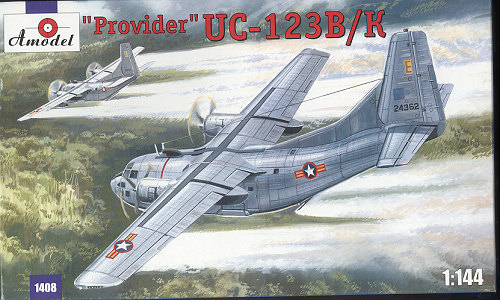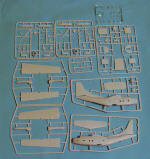
| KIT: | A-Model 1/144 UC-123B/K Provider |
| KIT #: | 1408 |
| PRICE: | $19.75 from www.greatmodels.com |
| DECALS: | Two options |
| REVIEWER: | Scott Van Aken |
| NOTES: |

| HISTORY |
It isn't very often that a successful powered aircraft is developed from a glider, but that is exactly what happened in the case of the C-123. This wasn't the first time this has happened, but the key here is successful. The Germans powered their Me-321 and Go-242 gliders with low powered French Gnome-Rhone radials and that did allow them to fly under their own power, but when loaded, they were really quite underpowered and somewhat dangerous to fly.
The C-123 was not in that category. Developed by Chase Aircraft as the XXX, this all metal glider would have been quite useful, but it was seen that the days of the troop and cargo carrying glider was over, so in cooperation with Fairchild, a powered version, soon to be designated C-123 was developed. It had all the modern requirements of a medium cargo aircraft, including a rear ramp that allowed easy access to the cargo compartment. About the only change was to add a huge fin fillet to overcome the torque of the engines. Basically, all the standard glider airframe was used and it was simply a case of adding the engines, nacelles and fuel tanks.
The aircraft grew in weight and it was seen that additional power was needed. To take care of the requirement, two J-85 jet engines, capable of using AVgas were attached under the wings and used for takeoff where the additional power was really needed. They were then shut down for normal flight. Some aircraft were also modified with a weather radar, but most C-123s were without it. Probably the most infamous use of the C-123 was to spread the defoliant 'Agent Orange', so called because of the orange markings on the 55 gallon drums. The C-123 soldiered on until the early 1980s with the USAF reserve. Some were sold to private cargo operators, many of whom used these planes as one-flight specials to smuggle in drugs.
| THE KIT |
 Typical of all the A-model kits I've seen, this one comes on a number of rather smallish sprues of off-white plastic. Molding is actually fairly good with nicely engraved panel lines where needed. Several of the sprues are duplicated as needed. The parts all show a small amount of flash, or you could call it 'extreme mold seams' if you wish. There is what seems to be an additional sprue with the spray tubes included. The clear sprue looks to be fairly well done, though the clear parts all have a number of stress lines in them and aren't crystal clear. However, it should be enough to see the rather complete cockpit section that has seats, sticks and consoles. There is also a rear door to gain access to the cargo bay. This is complete, but empty of any real detail. A few other observations are that the props are not squared and there are some sink areas on a few of the thicker parts. It also seems that the base sprues are the same for all versions. If you want to, and have the decals, you can do just about any standard 123 with the sprues in this kit. The radar nose is there as are the under wing drop tanks and pylons. As short as the wheelbase is on this one, I'd think that nose weight would be in order as well.
Typical of all the A-model kits I've seen, this one comes on a number of rather smallish sprues of off-white plastic. Molding is actually fairly good with nicely engraved panel lines where needed. Several of the sprues are duplicated as needed. The parts all show a small amount of flash, or you could call it 'extreme mold seams' if you wish. There is what seems to be an additional sprue with the spray tubes included. The clear sprue looks to be fairly well done, though the clear parts all have a number of stress lines in them and aren't crystal clear. However, it should be enough to see the rather complete cockpit section that has seats, sticks and consoles. There is also a rear door to gain access to the cargo bay. This is complete, but empty of any real detail. A few other observations are that the props are not squared and there are some sink areas on a few of the thicker parts. It also seems that the base sprues are the same for all versions. If you want to, and have the decals, you can do just about any standard 123 with the sprues in this kit. The radar nose is there as are the under wing drop tanks and pylons. As short as the wheelbase is on this one, I'd think that nose weight would be in order as well.
Instructions are well done with 13 construction steps. They make no mention of nose weight, and finding where to put some will be tough. Actually, I guess you could make up a cargo pallet, fill it will heavy 'stuff', and put it behind the cockpit. It does seem as if the intrepid could have the cargo ramp open if one wanted. Markings are for two aircraft, both equipped with spray equipment. One is USAF in overall ADC Grey with black areas around the cockpit and engine nacelles. The other is South Vietnamese in unpainted aluminum. Same deal on the black areas. Decals are fairly well done and though not perfect, are useable. The roundels both look a bit odd (perhaps the red 'bar' is too skinny and the white star doesn't reach out far enough. I do recommend using something like Microscale decal film to add more strength to these markings as the other A-model kit I've built had rather brittle decals. Of course, the brave can do theirs in SEA camo and use aftermarket letter/number sheets to do other variants.
the intrepid could have the cargo ramp open if one wanted. Markings are for two aircraft, both equipped with spray equipment. One is USAF in overall ADC Grey with black areas around the cockpit and engine nacelles. The other is South Vietnamese in unpainted aluminum. Same deal on the black areas. Decals are fairly well done and though not perfect, are useable. The roundels both look a bit odd (perhaps the red 'bar' is too skinny and the white star doesn't reach out far enough. I do recommend using something like Microscale decal film to add more strength to these markings as the other A-model kit I've built had rather brittle decals. Of course, the brave can do theirs in SEA camo and use aftermarket letter/number sheets to do other variants.
| CONCLUSIONS |
Well, we now have a relatively accurate C-123. I didn't notice any horrendous faults aside from a rather too 'rounded' windscreen. It is also a size that won't take over the model shelf. For sure it will take a bit of modeling skill to build as no A-model kit is a breeze.
February 2007
You can find this and other great kits atGreatModels
If you would like your product reviewed fairly and quickly by asite that has over 300,000 visitors a month, please contactme or see other details in the